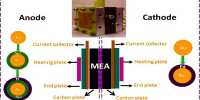Material scientists created a fast method for producing epsilon iron oxide and demonstrated its potential for next-generation communications devices. Its exceptional magnetic properties make it one of the most sought-after materials, particularly for the upcoming 6G generation of communication devices and for long-lasting magnetic recording. The work was published in the Journal of Materials Chemistry C, a journal of the Royal Society of Chemistry.
Iron oxide (III) is one of the most common oxides on the planet. It is most commonly found in the form of the mineral hematite (or alpha iron oxide, -Fe2O3). Maghemite (or gamma modification, -Fe2O3) is another stable and common modification. The former is commonly used in industry as a red pigment, while the latter is used as a magnetic recording medium. The two modifications differ not only in their crystalline structure (alpha-iron oxide has hexagonal syngony, whereas gamma-iron oxide has cubic syngony), but also in their magnetic properties.
Material scientists have developed a fast method for producing epsilon iron oxide and demonstrated its promise for next-generation communications devices.
In addition to these iron oxide (III) forms, there are more exotic variations such as epsilon-, beta-, zeta-, and even glassy. Epsilon iron oxide, -Fe2O3, is the most appealing phase. This modification has a very strong coercive force (the ability of the material to resist an external magnetic field). At room temperature, the strength reaches 20 kOe, which is comparable to the parameters of magnets based on expensive rare-earth elements.
Furthermore, due to the effect of natural ferromagnetic resonance, the material absorbs electromagnetic radiation in the sub-terahertz frequency range (100-300 GHz). The frequency of such resonance is one of the criteria for the use of materials in wireless communications devices; the 4G standard uses megahertz, while the 5G standard uses tens of gigahertz. There are plans to use the sub-terahertz range as a working range in sixth-generation (6G) wireless technology, which is set to be active in our lives in the early 2030s.
At these frequencies, the resulting material is suitable for the fabrication of converting units or absorber circuits. Using composite -Fe2O3 nanopowders, for example, it will be possible to create paints that absorb electromagnetic waves, shielding rooms from extraneous signals and protecting signals from interception from the outside. The -Fe2O3 material itself can be used in 6G reception devices.

Epsilon iron oxide is extremely rare and difficult to obtain a form of iron oxide. It is now produced in very small quantities, and the process can take up to a month. This, of course, precludes its widespread use. The study’s authors devised a method for accelerated synthesis of epsilon iron oxide capable of shortening the synthesis time to one day (that is, to complete a full cycle more than 30 times faster!) and increasing the yield of the resulting product. The technique is simple to replicate, inexpensive, and simple to implement in industry, and the materials required for synthesis—iron and silicon—are among the most abundant elements on Earth.
“Despite the fact that the epsilon-iron oxide phase was obtained in a pure form relatively recently, it has yet to find industrial application due to the complexity of its synthesis, for example as a medium for magnetic—recording. We were able to significantly simplify the technology “Evgeny Gorbachev, a Ph.D. student in the Department of Materials Sciences at Moscow State University and the work’s first author, says.
Research into the fundamental physical properties of materials with record-breaking properties is critical to their successful application. Without in-depth research, the material may be unjustly forgotten for many years, as has happened before in the history of science. The collaboration of materials scientists at Moscow State University, who synthesized the compound, and physicists at MIPT, who thoroughly studied it, was instrumental in the development’s success.
“Materials with such high ferromagnetic resonance frequencies have enormous practical application potential.” Terahertz technology is booming today: it is the Internet of Things, ultra-fast communications, more focused scientific devices, and next-generation medical technology. While the 5G standard, which was very popular last year, operates at frequencies in the tens of gigahertz, our materials are allowing us to operate at much higher frequencies (hundreds of gigahertz), which means we are already dealing with 6G standards and higher.
Now it’s up to engineers, we are happy to share the information with them and look forward to being able to hold a 6G phone in our hands,” says Dr. Liudmila Alyabyeva, Ph.D., senior researcher at the MIPT Laboratory of Terahertz Spectroscopy, where the terahertz research was carried out.















